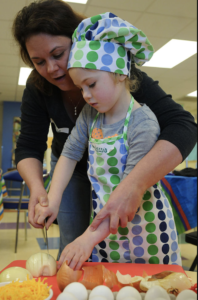Kids will eat healthier and you’ll prepare them for life on their own if you teach them how to cook at an early age. Even teenagers will get into preparing their own meals if you introduce them to cooking in a fun way.

Create meal menus
The first step in teaching kids to cook is to get them excited by letting them cook their favorite dishes and meals. While you might want them to learn how to make a roast or a lasagna, kids (especially younger ones), might start out wanting to make pizza, mac and cheese and hamburgers. Those are actually good starter dishes because they’re so easy to make.
In addition to individual dishes, ask your kids to suggest complete breakfast, lunch and dinner menus for the family. Ask them what they think would please everyone in the family. Once you have your menus, break down each item you’re going to cook by its ingredients, the pots, pans and utensils you’ll need, and your approximate cook time.
Create shopping lists
Now that you know exactly what you need for your child to make his or her first meal, write a list of all the ingredients you’ll need. You might have everything you need in the house, but you might also need to make a trip to the grocery store for some items.
Start with shortcuts
It might be a better idea to get your child interested in cooking by having him or her prepare several easy items, rather than a more complex dish. For example, instead of making macaroni and cheese from scratch, use a boxed mix. Your child will still have to follow directions, measure the water and butter, boil the water correctly (no salt and keep it covered until it boils), watch the cook time and blend the ingredients. As your child shows more of an interest in cooking, then you can suggest made-from-scratch items.
Go shopping
Head to the supermarket with your list and let your child pick out the items. Ask him or her to compare different brands, read the nutrition labels and compare prices. This will help you put your child on a path to better eating habits as he or she learns that some foods that seem the same are healthier than others. Let your child see the difference between fresh, canned and frozen foods, and introduce her or him to organics. To make your child’s learning experience even more interesting, stop by a local farmer’s market so he or she can meet the people who grow the foods you eat.
Teach prep work
Once you’re back in the kitchen, it’s time to start cooking. Have plenty of counter space available and all of your equipment and ingredients set up. Teach basic food prep skills, such as the difference between dicing vegetables and making a julienne cut. Teach hygiene, such as having kids wash their hands after they work with meat and fish, to prevent the spread of bacteria. Other prep skills include pre-heating an oven, defrosting in a microwave, letting proteins get to room temperature before cooking, cracking eggs, separating the yolk from eggs, and using a hand whisk, blender and food processer.
Let’s get cookin’!
If possible, have written recipes kids can follow without much instruction from you. Comment as needed, or wait to answer questions. Be liberal with praise any time your child does something correctly – make sure most of your interaction with your child is positive, not correcting.
Set the table
Presentation is an important part of serving a great meal. Ask your child how he or she wants to set the table, what bowls you should use for the sides and the main dish, and if she or he wants to serve individual salads or present a pass-around, serve-yourself salad bowl. Ask about a centerpiece and room lighting. When you’re ready to serve, let your child present the menu, share some of the cooking techniques he or she used, and explain why the foods are healthy or taste the way they do.
Clean up time
After the meal is over, resist the temptation to let the cook “have the rest of the night off” while the family cleans the table and washes the dishes. Understanding how to pack up leftovers and how much work cleanup goes into cleanup will add to kids’ cooking lessons and prepare them for when they leave the nest.